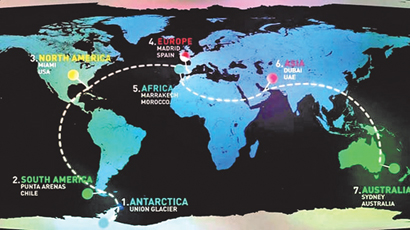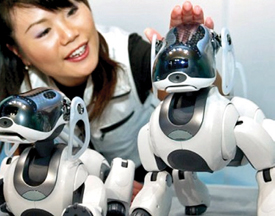|

Seven marathons in
Seven days and in
Seven continents
 Running a 26.2 mile marathon is itself an unimaginable task for us. Running a 26.2 mile marathon is itself an unimaginable task for us.
But imagine a man completing seven marathons in seven days and for
that matter in seven continents.
This is what 31-year-old Tim Durbin of San Francisco achieved
recently. Durbin was the only American who competed in the World
Marathon Challenge that started on a Saturday and ended in Sydney the
following Friday last month.
 He ran 26.2-mile marathons in Antarctica, Chile, Miami, Madrid,
Morocco, Dubai and Sydney. “In the past 48 hours, I’ve slept less than
nine hours and ran three marathons,” he said. He ran 26.2-mile marathons in Antarctica, Chile, Miami, Madrid,
Morocco, Dubai and Sydney. “In the past 48 hours, I’ve slept less than
nine hours and ran three marathons,” he said.
He said most of his sleep was on the airplanes between cities with a
few hours spent in hotels following the races. He did have one full
night of rest after running in Chile and before heading to Miami. Durbin
added that the biggest challenge has been the quick turn-around times.
“Twice we did two marathons in 24 hours,” he said.
The Morocco marathon was the toughest where he started running in
Marrakech less than seven hours after he completed the race in Spain.
Durbin averaged about five-and-a-half hours for each 26.2-mile
marathons, while the race in Morocco took nearly six hours. Durbin spent
roughly $37,000 to participate with 11 others runners.
The World Marathon Challenge is part of a bigger challenge that
Durbin started two years ago. In 2013, he started logging his miles for
walking, running, cross country skiing and swimming to complete the
distance around the equator 24,901 miles before 2022.
Yes he is really the Marathon Man
Special funerals for pet robot dogs
 In Japan they are treated as living animals. Most probably in another
10 or 15 years time there may not be living dogs in Japan. These AIBOs
robotic dogs sold by Sony Corp between1999 and 2006 are equipped with
Artificial Intelligence [AI] are capable of developing their own
personalities and making them to be loved by their owners. In Japan they are treated as living animals. Most probably in another
10 or 15 years time there may not be living dogs in Japan. These AIBOs
robotic dogs sold by Sony Corp between1999 and 2006 are equipped with
Artificial Intelligence [AI] are capable of developing their own
personalities and making them to be loved by their owners.
The attachment and love are so great that when the ‘pet” robotic dog
breaks down the owners bury them with a proper funeral that do for a
real pet.
To understand the strange practice of burying a robot, you’ve got to
understand exactly how popular Aibos are in Japan. When Sony rolled out
the first generation Aibo in 1999, the initial batch of 3,000 units were
sold out in 20 minutes flat, in spite of the $2,000 price tag. In the
following years, over 150,000 units of various Aibos models were sold.
But Sony was in trouble in 2006, so Aibo, the expensive luxury pet,
was discontinued. The company did keep their ‘Aibo Clinic’ open until
March last year. But then they decided to further cut costs by shutting
down the maintenance unit, and owners had to look elsewhere for help
with spare parts.
Unfortunately, they are hard to come by, which means that when Aibos
dogs break down, most of them leave their owners forever. So the only
option for the owners to deal with the loss is by organising a real
funeral.
The funerals held for the ‘dead’ Aibos are quite similar to any other
in Japan. The dogs are lined up on the altar, each wearing a tag to show
where they came from and which family they belonged to.
Fifty-nine-year-old Nobuyuki Narimatsu, who heads an electronics repair
company specialising in fixing vintage products says that the owners
feel the robot dogs have souls as long as they with them..
 Seventy-year-old Hideko Mori, for instance, had her Aibo pet for
around eight years, and always treated it like a real dog. “He doesn’t
require feeding and he doesn’t pee,” she said. “I never thought there
was a limit to his life.” But in May last year, her beloved Aibo stopped
moving. She tried to get it fixed, and even sent an email to Sony on
behalf of the dog: “Do I have no choice but to die like this because I
can’t walk?” Seventy-year-old Hideko Mori, for instance, had her Aibo pet for
around eight years, and always treated it like a real dog. “He doesn’t
require feeding and he doesn’t pee,” she said. “I never thought there
was a limit to his life.” But in May last year, her beloved Aibo stopped
moving. She tried to get it fixed, and even sent an email to Sony on
behalf of the dog: “Do I have no choice but to die like this because I
can’t walk?”
Thankfully, the engineer who read the email introduced Hideko to A
FUN, a company that employs former Sony engineers - they were able to
fix the robot in two months. “I was so happy to see him back to health
at home,” she said.
The only source of genuine parts for an ailing Aibo is from ‘dead’
robots. But it’s tough to get access to these parts, so repairs could
take anywhere between a few weeks to a couple of months to complete. In
some cases, even that isn’t possible, and the owners have to come to
terms that their much loved robots are ‘dead’. This is especially tough
for the Japanese, who really consider robots to be man’s best friend.
Sumie Mekawa, 72, said that since she and her husband have no
children, they call their Aibo ‘Ai-chan’ and treat it like a daughter.
She talks to the robot every day, travels with it and makes clothing for
it. And she has an agreement with her husband - whoever lives longer
will ultimately be cremated alongside the dog.
“I can’t imagine how quiet our living room would have been if Ai-chan
wasn’t here,” she said. “It will be sad when the day finally comes when
Ai-chan is unable to stand up.” |

